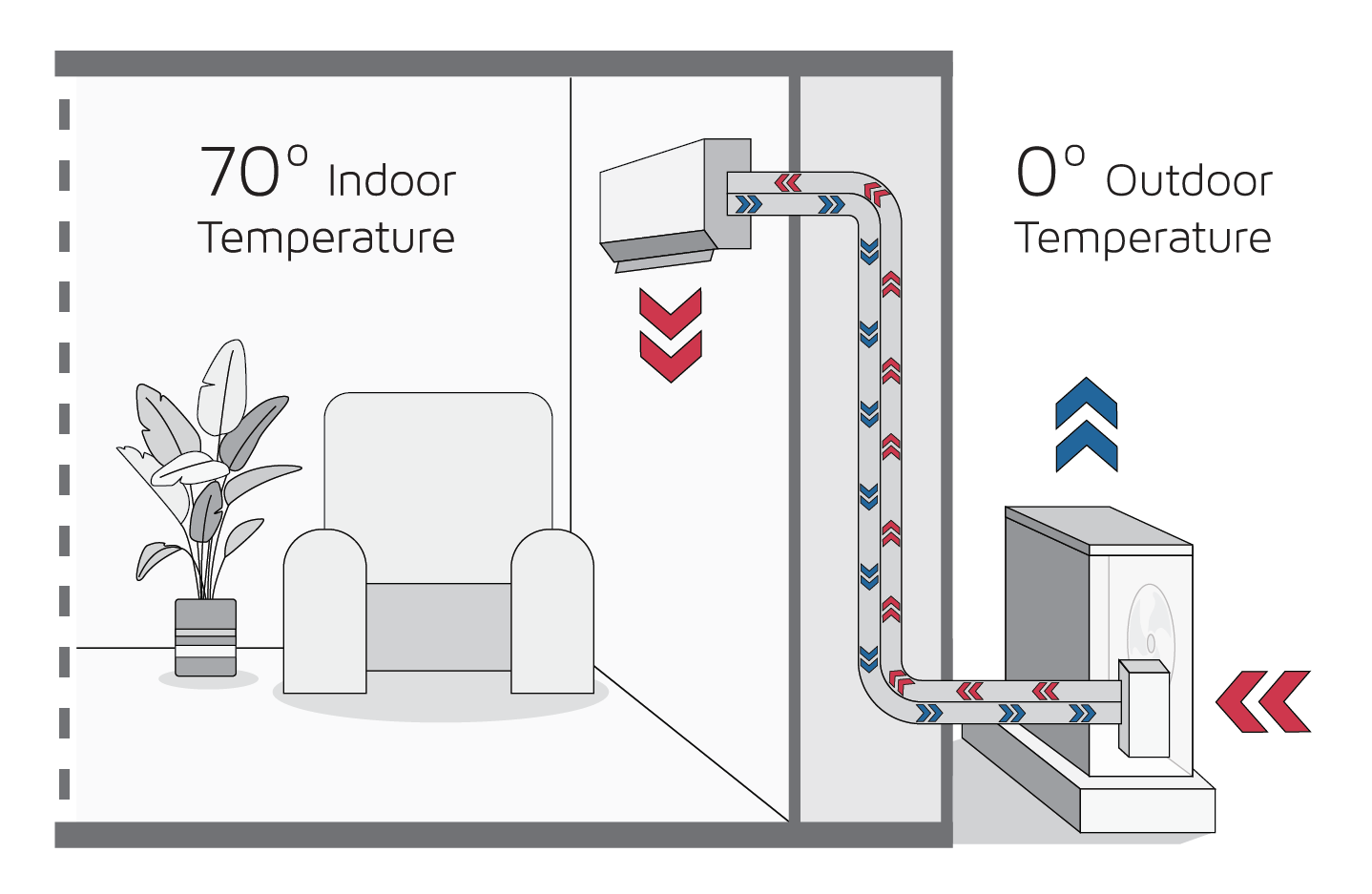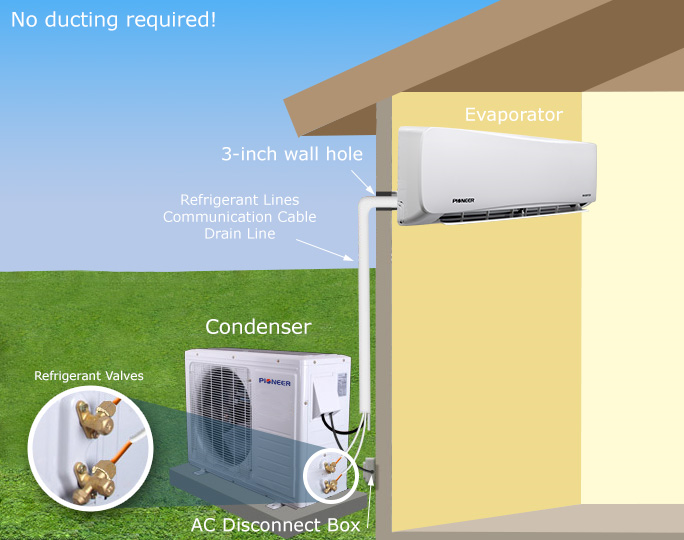How Does Mini Split Air Conditioner Work

One of the most frustrating problems homeowners face with mini-split air conditioners is reduced cooling performance. Your unit might be running, but the room isn't getting as cool as it used to, or it's taking much longer to reach the set temperature. Before you call a professional, let's explore some simple troubleshooting steps you can take.
Step 1: Initial Assessment and Safety First
Before you touch anything, ensure your safety. Turn off the power to both the indoor and outdoor units at the circuit breaker. This is crucial to prevent electrical shock. Then, take a moment to observe the system. Are there any unusual noises coming from either unit? Is there ice buildup on the outdoor unit's refrigerant lines? Is the indoor unit displaying any error codes?
Tools you might need:
- Screwdriver (Phillips head)
- Soft brush or vacuum with a brush attachment
- Fin comb (optional, for straightening bent fins)
- Multimeter (for more advanced testing, only if you're comfortable and qualified)
Step 2: Check the Air Filters
This is the most common cause of reduced cooling. Dirty air filters restrict airflow, making the unit work harder and less efficiently. Locate the air filters on the indoor unit (usually behind a removable panel). Remove them and inspect. If they're visibly dusty or clogged, they need cleaning or replacement.
Cleaning Procedure:
- Vacuum: Use a vacuum cleaner with a brush attachment to remove loose dust and debris.
- Wash (if applicable): Some filters are washable. Rinse them with lukewarm water, gently scrubbing with a soft brush if needed. Do not use soap unless the manufacturer specifically recommends it.
- Dry completely: Allow the filters to air dry completely before reinstalling them. Never put wet filters back in the unit.
- Replace (if disposable): If your filters are disposable, simply replace them with new ones of the correct size.
Frequency: Ideally, clean or replace your air filters every 1-3 months, depending on usage and air quality.
Step 3: Inspect the Outdoor Unit
The outdoor unit is responsible for releasing heat. If it's blocked or dirty, it can't do its job efficiently.
Checking for Obstructions:
- Clear debris: Remove any leaves, branches, grass clippings, or other debris that may be blocking the unit's fins.
- Check for proper clearance: Ensure there's adequate space (usually at least 2-3 feet) around the unit for proper airflow. Avoid planting shrubs too close to the unit.
Cleaning the Fins:
- Turn off the power: Again, safety first!
- Use a garden hose (gentle spray): Rinse the fins from the inside out to remove dirt and debris. Avoid using a high-pressure nozzle, as this can damage the fins.
- Fin comb (optional): If the fins are bent, you can use a fin comb to gently straighten them. Be careful not to apply too much pressure.
Step 4: Check for Ice Buildup
Ice buildup on the refrigerant lines of the outdoor unit can indicate a problem. This can be caused by:
- Low refrigerant: This is a common cause and requires professional attention.
- Restricted airflow (indoor): A severely clogged air filter (as addressed in Step 2) can cause ice buildup.
- Low ambient temperature: Some mini-split systems are not designed to operate efficiently in very cold temperatures. Check your unit's specifications.
What to do if you find ice:
- Turn off the unit: Allow the ice to melt completely.
- Check air filters: Ensure they are clean.
- Restart the unit: Monitor the unit closely. If the ice returns quickly, it likely indicates a refrigerant leak or other serious problem requiring a professional.
Step 5: Thermostat Settings and Remote Control Issues
Sometimes the problem isn't the unit itself, but the settings or the remote control.
Thermostat Settings:
- Mode: Make sure the unit is set to "Cool" mode.
- Temperature: Ensure the temperature is set low enough.
- Fan speed: Try increasing the fan speed to improve airflow.
- Timer settings: Check that the timer isn't set to turn the unit off prematurely.
Remote Control Issues:
- Batteries: Replace the batteries in the remote control.
- Line of sight: Ensure there's a clear line of sight between the remote control and the indoor unit.
- Remote sensor: The remote sensor on the indoor unit might be dirty or damaged. Clean it gently with a soft, dry cloth.
Step 6: Check the Condensate Drain Line
Mini-split systems produce condensation, which needs to be drained away. A clogged condensate drain line can cause water to back up, potentially leading to reduced cooling and even water damage.
Locating the Drain Line: The drain line is usually a PVC pipe that exits the indoor unit and runs either outside or to a drain.
Checking for Clogs:
- Inspect the outlet: Look for any signs of blockage, such as debris or algae growth.
- Use a wet/dry vacuum: Attach the vacuum hose to the end of the drain line and try to suck out any clogs.
- Pour in vinegar: If the vacuum doesn't work, try pouring a cup of white vinegar into the drain line. This can help dissolve minor clogs. Let it sit for 30 minutes, then flush with water.
Step 7: Listen for Unusual Noises
Pay close attention to any unusual noises coming from the indoor or outdoor units. These noises can provide clues about potential problems.
Possible Noises and Their Meanings:
- Banging or rattling: Loose components, such as fan blades or screws.
- Squealing: Worn-out motor bearings or belts (if applicable).
- Hissing: Potential refrigerant leak (this requires professional attention immediately).
- Buzzing: Electrical issues, such as a faulty capacitor or contactor (this requires professional attention immediately).
When to Call a Professional
While many mini-split problems can be resolved with simple DIY troubleshooting, some issues require the expertise of a qualified HVAC technician. It's crucial to know when to stop and call for help.
You should call a professional if:
- You suspect a refrigerant leak: Refrigerant leaks are harmful to the environment and require specialized equipment to repair.
- The unit is making loud or unusual noises: This could indicate a serious mechanical or electrical problem.
- The unit is not cooling or heating properly after you've tried the troubleshooting steps above.
- You see ice buildup that returns quickly after melting.
- You are not comfortable working with electrical components.
- You are unsure about any aspect of the troubleshooting process.
- Your unit is still under warranty: Attempting repairs yourself may void the warranty.
Specifically, NEVER attempt to:
- Work on the refrigerant lines yourself.
- Disassemble the compressor.
- Attempt any electrical repairs unless you are a qualified electrician.
Finding a Qualified Technician:
- Check online reviews and ratings.
- Ask for referrals from friends, family, or neighbors.
- Verify that the technician is licensed and insured.
- Get a written estimate before any work is performed.
Preventative Maintenance
The best way to avoid mini-split problems is to perform regular preventative maintenance. This includes:
- Cleaning or replacing air filters regularly.
- Keeping the outdoor unit clear of debris.
- Inspecting the condensate drain line.
- Scheduling annual professional maintenance: A qualified technician can inspect the system, check refrigerant levels, and perform any necessary repairs.
By following these troubleshooting steps and preventative maintenance tips, you can keep your mini-split air conditioner running efficiently and avoid costly repairs. Remember, safety is always the top priority. If you're ever unsure about anything, don't hesitate to call a professional.










